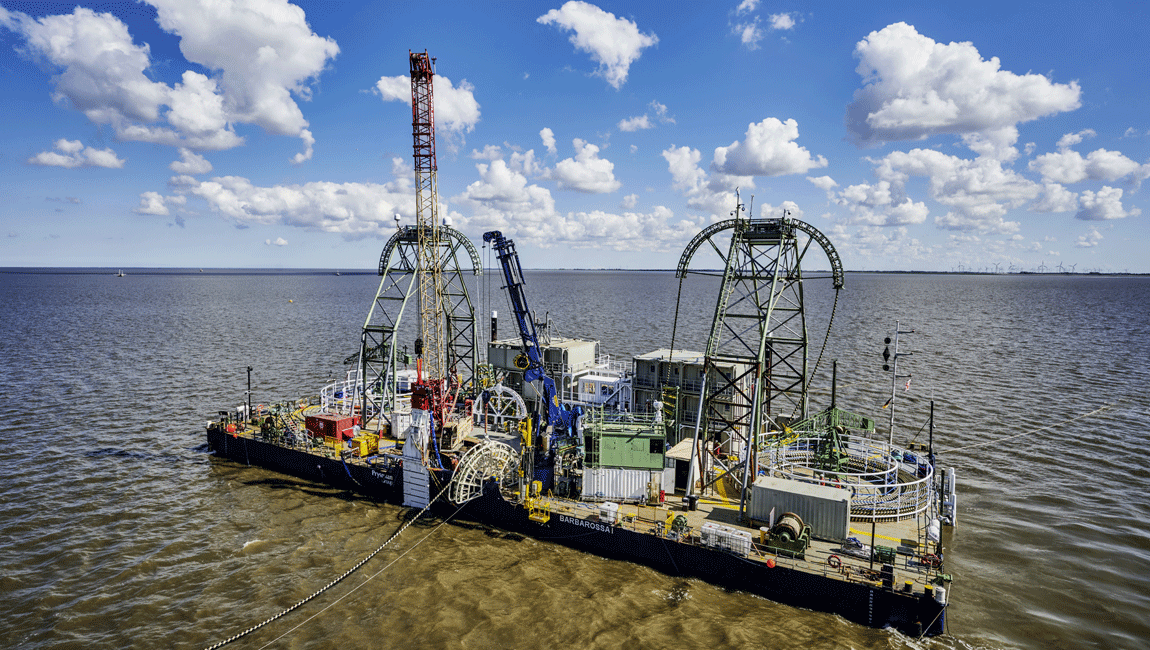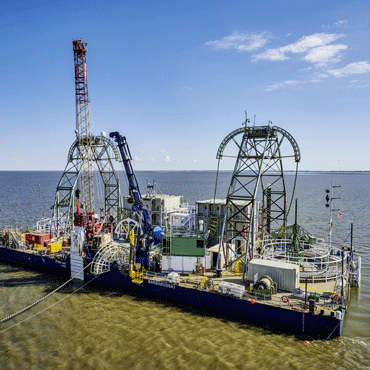After the debut of the state-of-the-art 170-meter Leonardo da Vinci in August 2021, Prysmian Group’s fleet would seem to be complete. But with the addition of Barbarossa I, Prysmian Group becomes the first company in the sector that can provide the full range of submarine cable-laying solutions from the shallowest coastal waters in Northern Europe to the profoundest depths of the Mediterranean Sea. Moreover, it can execute projects in shallow waters without recourse to a subcontractor.
Welcome Barbarossa I, a new vessel to be added to Prysmian's fleet

Prysmian Group’s fleet of four advanced cable laying vessels Leonardo Da Vinci, Giulio Verne, Cable Enterprise, and Ulisse has now increased to five with the purchase of Barbarossa I, a 67-meter-long ultra-shallow-water barge.
In addition, Prysmian Group announced an investment of approximately €200 million in a new cutting-edge cable-layer plus adjustment for cables equipment of approximately €40 million. The new vessel will be fully operational by Q1 2025 and will reinforce Prysmian’s project execution capabilities and its EPCI approach. The new cable-laying vessel will be very similar to Leonardo da Vinci, which was delivered in 2021 and exceeded all expectations in its first year of operations, being fully recognised by the market as the best-in-class vessel to meet the growing demand of the submarine cable industry. As for Leonardo da Vinci, the new vessel will be built by the VARD Group (part of Fincantieri).


“We are providing our clients the full package in-house”
“We acquired Barbarossa I to round out our equipment portfolio, so that we can carry out a series of activities that are specific to areas with these shallow conditions.”

Valerio Acquaotta
Head of Installation for Marine Operations at Prysmian Powerlink.
Barbarossa I’s maiden voyage for Prysmian Group has been to the tidal flats of the northern coast of Germany, where Prysmian Group is installing approximately 130 kilometers of land and submarine cables for the DolWin5 offshore grid connection project commissioned by transmission system operator TenneT. The turnkey connections will link the offshore converter platform DolWin epsilon, located approximately 100 km off the German coast in the North Sea, to the mainland Emden/Ost converter station, with the purpose of transmitting the generated renewable energy into the German grid.
For an EPCI contractor like Prysmian, every project is unique. In the case of DolWin5, the route calls for three different vessels depending on water depth. The final stretch of the installation took place in the very shallow waters of the Wadden Sea that runs along the coasts of Denmark, Germany and the Netherlands. Near the shore, the water is only around 1.5-2 meters deep, and comes and goes with the tides, meaning that only smaller barges like Barbarossa I are suitable. Prysmian Group can use Cable Enterprise for the deeper waters at 60 kilometers from the shore. For the intermediate distance of 30 kilometers from shore, the 136-meter-long Ulisse can do the job. And Barbarossa I took over for the final 4 kilometers nearest the coast.
“The DolWin5 project has established Prysmian Group’s successful track record for executing projects in shallow waters with a smaller barge”

Raffaele Boccara
DolWin5 Project Manager
Barbarossa I has been outfitted with new cable installation equipment such as cable linear engines, winches, cable tanks, and monitoring and control systems. For DolWin5, it has been equipped with a vibro sword capable of burying cables under the seabed. Half of the 30-kilometer land route in Lower Saxony was completed in 2021. This year Prysmian finished the remaining land portion and began the Wadden Sea and near shore portion. The offshore segment will be completed in 2023. The project will wrap in January 2024.
In addition to new equipment, Barbarossa I has been able to house 30 people without the need for an accommodation barge alongside as in the past. This innovation reduces the barge’s environmental footprint, which is important considering that the Wadden Sea is a UNESCO Heritage Site, explained Andrea Colombo, project manager at Prysmian Group, who oversaw the offshore portion of the DolWin5 project.
“The tidal flats completely dry out when the tide goes out, and therefore are home to a large number of protected bird species, as well as a rest area for seals,” said Andrea. “We had a dedicated environmental advisor on board both Barbarossa I and Ulisse to monitor animal activity with binoculars to make sure we are not disturbing the fauna.”

Andrea Colombo
Project manager at Prysmian Group




